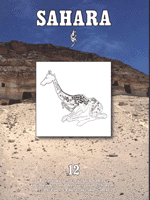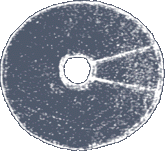| Contents
Abstracts |
Abstracts of Sahara volume 12
(published May 2001)
|

|
Rifaat Abdel Kareim Osman and Steven E. Sidebotham
Geomorphology and archaeology of the central Eastern Desert of Egypt
ABSTRACT
The geomorphic features of the central Eastern Desert reflect several climatic and structural processes. The most important of these are the high horsted Red Sea Mountain Zone and the hummocky zone on both sides. Hogbacks are common mostly due to faulting whereas the cuestas probably were related to basement uplift. Fluvial processes led to many wadis in the area and also to alluvial fans, piedmont plains and terraces. Reversals in the wadi slopes were due to post-wadi uplift in their downstream sides. The study area under consideration preserves a large number and wide variety of archaeological sites from all periods. This paper provides a brief overview of the more important remains from the Ptolemaic, Roman and early Christian eras.
|
|
Top

|
Mario Liverani
Looking for the southern frontier of the Garamantes
ABSTRACT
The Joint Italo-Libyan Mission to the Tadrart Acacus and Messak of the CIRSA (University of Rome «La Sapienza») is investigating new avenues of research, including the archaeology of the protohistoric and historical periods. The Garamantian citadel Aghram Nadharif, near the Barkat oasis and dating back to the third and fourth centuries, is being excavated and is already the most important Garamantian site outside the Germa area. Moreover, other testimonials of the Garamantes period have been found at Fehwet and in the Irlarlaren pass. A detailed reconstruction is made of the southern frontier of the Garamantes kingdom and the caravan network that connects Fezzan with the central and western Sudanese regions (the Chad basin and the Niger bend). The transition from the Late Pastoral horizon to the Garamantes period, with the related questions regarding the domestication of the camel, the working of iron and the salt trade, is becoming more and more clear. |
|
Top
|
François Soleilhavoup avec la collaboration de Philippe Masy et Hélène Delusset, Salah Gomani, Jacques Guerrier, Nicole Honoré, Ali Kane, Emmanuelle Monnery, François et Françoise Pottier
Art rupestre dans les confins nord-orientaux du Tassili-n-Ajjer (région de l’Aramat, Libye)
ABSTRACT
Three surveys in the Aramat area, both in the wadis and in the plain west of the Titersine Erg, reavealed the presence of over 80 sites and hundreds of paintings. These discoveries made it possible to talk in terms of a new “province” of Saharan rock art. In the light of the important material obtained, a few large recurrent themes regarding central Saharan art are addressed. The debates concerning a few questions are reopened, such as the chronocultural position of the Bubalus antiquus and the so-called Tazina technostyle. Six shelters showing unusual paintings of the Round Head school make one wonder how large this group was and what its animistic practices were. The numerous drawings of the pastoral period, in the Iheren Tahilahi and Ti-n-Aneuin styles, open new chronological perspectives. The presence of four chariots in this area and another north of the Acacus makes it necessary to reconsider the longevity of the chariots and their use.
|
|
Top
|

Robert Vernet
Un habitat de l’âge du cuivre (2500 BP) de la région de Nouakchott (Mauritanie occidentale): Imbich-Est
ABSTRACT
The Imbich-Est site, 25 km north of the Nouakchott, is the Bouhdida culture’s most noted settlement and the only chalcolite group in western Mauritania about which we have coherent information. Between 2600-2500 B.C. some hunters and fishermen settled on a few sandy hills not far from the coast. The region was devoid of stony raw material and had a material culture that was quite rich. There are quite a few copper items and stone implements which are decidecly Neolithic. The stone material was imported from the north and northeast as, presumably, were the copper items. Who the people of the Boudhida culture were is unknown, the phases preceding and following this population remain a mystery. At no other time the Boudhida pottery ever had any equivalent in the region. |

|
Heiko Riemer and Rudolph Kuper
«Clayton rings»: enigmatic ancient pottery from the Eastern Sahara
ABSTRACT
In the early thirties Patrick Clayton, while surveying the Libyan Desert in Egypt, discovered a few mysterious ceramic objects which had no parallels in ancient pottery. The pieces consist of standardised rings open at both ends, and perforated disks which were always found with the rings. During the eighties and nineties numerous sites with Clayton rings were found by the B.O.S. and ACACIA expeditions. The paper summarises data and evidence concerning this kind of pottery which was distributed over the deserts and oases of Egypt and northern Sudan. Potmarks and radiocarbon dates suggest a Predynastic or Early Dynastic age, and therefore hyperarid conditions. Although recent research has yielded a lot of details about the Clayton rings, their function and use remain unclear. |
|
Top
|
Andrew B. Smith
Ideas on the later cultural history of the Central Sahara
ABSTRACT
There has been very little archaeological research into the history of the present distribution of Saharan people. Changing funerary monuments through time in the central Sahara may be indications of large scale movements of humans within the last 4000 years, but there is very little other data to show what the influences were, and from where the people came. |
|
Top
|
Felice Cesarino
Cani e mufloni: protagonisti della più antica forma di controllo culturale delle risorse animali nel Sahara?
ABSTRACT
Original forms of animal management are found in the Sahara of prehistoric times, together with an intensive cynegetic type of exploitation that later led to the actual domestication and raising of animals. This phenomenon can only be evidenced at the ethnological and iconographical level. Even authors who have been very attentive as regards the origin, development and role of animal raising have neglected these unusual aspects. This might be explained by the fact that this transitional phase of the culture left no biological evidence that could be traced to the domestication of animals. Once again, this proves that certain phenomena cannot be reconstructed exclusively at the peleontological and archeological level; and that rather than looking for clues that do not exist, what needs to be done is appropriately evaluate the available evidence, whatever it happens to be. |
|
Top
|
Mario Liverani, Mauro Cremaschi and Savino Di Lernia
The «Archaeological Park» of the Tadrart Acacus and Messak Settafet (south-western Fezzan, Libya)
ABSTRACT
The increasing tourist activity and the expansion of oil prospecting in Libya represent a dramatic danger for one of the most important archaeological areas in the world, a UNESCO World Heritage site since 1985: the Acacus range and Messak plateaus. The overexploitation of trees and water, pollution and alteration of the archaeological landscape are the immediate effects of the huge influx of tourists, after the removal of the embargo and the opening of Libyan frontiers to foreign visitors. New roads and airstrips, and intensive oil drilling are going to be a major element of danger in the Messak Plateaus and surrounding sandy region, where an immense oil field has recently been discovered. The Libyan authorities are trying to reconcile the need of development with the safeguard of the cultural heritage. It is a difficult and demanding task, and some foreign archaeological missions are trying to support the Department of Antiquities of Libya with archaeological rescue operations and with the establishment of a preliminary project for the constitution of an archaeological park in the region. |
|
Top
|

https://www.saharajournal.com
e-mail: reception@saharajournal.com
Last update Monday, September 2, 2013
|
|
|
|
|

